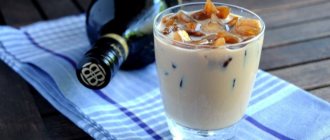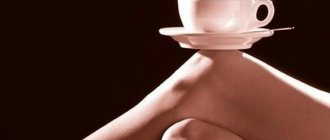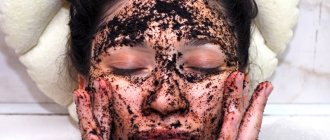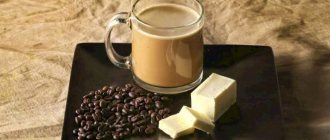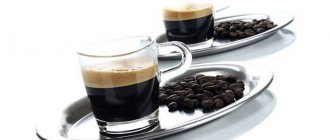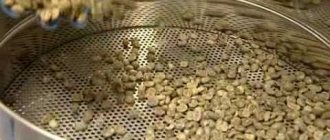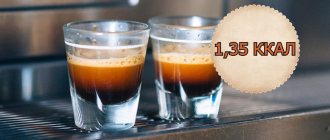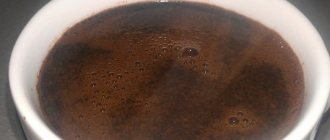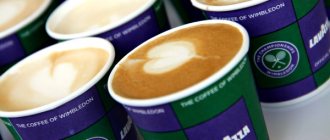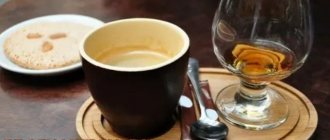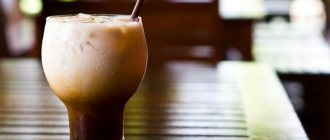Rules for making coffee - secrets
Regardless of which method of brewing coffee at home is used, it is important to follow the following rules:
- Take only clean water, preferably filtered and soft. Then all the flavors of the grains will turn into liquid. In bars, special reverse osmosis filters are installed for this purpose - they provide practically distilled water.
- Use only fresh grains. For one person, it is better not to buy large packs - it is enough to stock up for a week. If expiration dates are not indicated, it is better to buy elsewhere. One of the secrets is that grains are stored better in the freezer.
- Follow brewing technology if manual methods are used.
Not only the method of preparing coffee affects the quality of the drink. It is necessary to provide for other nuances.
Drip method
The development of engineering could not ignore the area of coffee preparation. Repeated attempts to mechanize the process were crowned with the first success at the very beginning of the 19th century, when the prototype of the modern drip coffee maker first appeared.
This method involved dripping pre-heated water rather slowly through the ground coffee. The extraction process took longer, resulting in a stronger drink.
This principle still underlies all existing drip coffee makers today.
What affects taste and strength
To get the most delicious coffee, you need to consider:
- Degree of grain grinding.
- Storage method.
- The percentage of Arabica and Robusta in the blend. Arabica gives a mild taste, robusta is bitter and sour.
- The amount of ground grain per serving. The more, the stronger the drink will be.
- The presence of artificial aromatic and flavoring additives.
- The speed of coffee preparation, or rather, the speed at which water passes through the coffee tablet.
There are 3 main degrees of grinding of grains - coarse, medium, fine. Within each there are more gradations - about 3 for each type. There are 9 degrees in total. For example, to grind beans for the Turkish method of brewing ground coffee, you need to turn them into flour.
This cannot be done using an electric device - you need a manual burr coffee grinder. After it, the drink turns out thick and rich, with dense foam. In cocktails, such coffee will give a bright shade of taste that is impossible not to notice.
The strength can be adjusted not only by grinding, but also by brewing. For example, Italians are very fond of ristretto. It has a rich taste, but does not differ in strength. Here's the secret: the amount of caffeine increases over time.
The longer the hot water passes through the layer of beans, the stronger the drink. Only the first portion of coffee, with aromatic oils, goes into the ristretto. The caffeine remains in the grounds or is poured into another cup and disposed of. This way you can try many varieties without overdosing on caffeine.
If you infuse the powder in cold water for several hours, you can increase the strength as much as possible. This method of preparing ground coffee takes time, but you can make a supply for several days at once and keep it in the refrigerator.
The longer grains are stored, the worse their taste becomes. If the pack is not closed, the aroma will disappear. The oil on the surface of the grain may begin to taste bitter. No matter what type of coffee brewing is used, the drink will be bad.
The composition of the mixture affects the taste, but there is no single advice here, since everyone prefers to choose a blend according to their preferences. There are even lovers of pure Robusta. According to reviews, they wake up in the morning not so much from caffeine as from bitterness. For some, Robusta helps improve problems with the intestines and gallbladder, forcing these organs to work.
The amount of powder per serving of espresso is also individual. The more, the stronger the coffee, the more caffeine it contains.
Catering business
The taste of coffee depends on the degree of roasting of the beans. Types of frying and their purpose are given in table. 3.8.
Different types of coffee have their own methods of preparation and serving (Appendix 26, 277).
Espresso *31 is a coffee drink made by passing hot, but not boiling, water through ground coffee, which is an emulsion formed from the oils of the coffee beans. This is where the main features of the drink lie: “cream” - a characteristic foam on the surface, dense consistency, delicious aroma. Under no circumstances should you use sugar substitutes - the drink will be spoiled.
* 31: {In Chinese, “espresso” is translated as “squeezed, compressed”}
Rice
.
3.19. Irish glass
Table 3.8
TYPES OF Roasting
| Roasting intensity | Types of roasting | Purpose | Roasted coffee color |
| Weak | New England, weak | Fragile, morning coffee, coffee with milk | |
| Average | American, regular, brown | French press, filter coffee | |
| Strong | French, weak | French press, filter coffee | |
| Highest degree | Oriental, Italian, Continental, Indian, French | Espresso, oriental coffee |
Preparation of espresso consists of six main stages: preparing the holder for work (while waiting for orders, the holder must be warmed up, a serious mistake is to keep it on the desktop or sink) dosing coffee (there are two methods of dosing: automatic and grinding in the holder, which is used during barista championships , as well as in gourmet establishments) forming a coffee tablet using a tempera (a properly prepared coffee tablet does not spill out of the holder) preparing an espresso machine for operation (pouring hot water through a group of mechanisms for 3-4 seconds to restore operating temperature mode) extraction (from the moment the spill is turned on until the drink comes out, 4-6 seconds are spent) waste removal and cleaning (knocking a coffee tablet into a container, wiping the inside of the holder from coffee residues).
If espresso is brewed correctly, the crema (foam) corresponds to the following indicators: reddish-brown (the color of a hazelnut shell); durable, thick, more than 2 mm thick; continuous, without breaks; homogeneous, without large bubbles; stand, lasts more than 2-3 minutes, “alive”, restored after stirring the drink, has dark brown stripes or spots (tiger or leopard skin) (Fig. 3.20, 3.21).
Rice
.
3.20. Classic espresso
rice
.
3.21. Espresso “Romano” with lemon juice
Espresso aroma: positive types - roasted, fruity, floral; negative types - smoky, rancid, herbal, straw, rotten.
Taste of espresso: positive shades - sour, wine, citrus, chocolate, pleasant bitterness, floral, balanced; negative shades of taste - astringent, earthy, mealy, wooden, sour, medical (pharmacy), corky.
In Italy, there are rules for the best espresso - the “law of four M”: the first (igspeiia) is the mixture of coffee beans, the second (tassipago) is the degree of grinding, the third (tasspipe) is the coffee maker and the fourth (tapo) is the bartender’s hand.
Cappuccino coffee (sarissipo) is coffee with milk whipped into hot, thick foam. The milk is churned to enhance the taste and visual sensations of the coffee. There are many methods of preparation and types inherent in this drink. To obtain good milk froth, coffee machines have a special steam-shaped tube with a nozzle through which steam is forced under pressure. Having switched the coffee maker to the “cappuccino” or “steam” mode, the straw is directed into a glass with milk. In a few minutes the foam will be ready (Fig. 3.22, 3.23).
Caffe latte (literally means “milk”). Prepared from the best varieties of coffee. The composition of the latte coffee as an ingredient includes one part espresso and three parts milk with a small addition of foam, which can be sprinkled with chocolate or cinnamon (cinnamon gives coffee a special piquancy) (Fig. 3.24, 3.25).
Rice
.
3.22. Classic cappuccino Fig
.
3.23. Cappuccino with cinnamon
Rice
.
3.24. Classic latte Fig
.
3.25. Latte with syrup
Milk should be whole, pasteurized, fat content 3-3.5%, cooled to a temperature of 4 ° C. It should be noted that its whipping is influenced not by fat content, but by protein compounds. When whipping, you should remember that the milk cannot be heated above 65 ... 75 C, otherwise the protein compounds will begin to collapse and the milk will acquire a boiled taste.
Well-frothed milk meets the following requirements: uniform structure; consists of microscopic bubbles; does not contain large bubbles, has a pleasant fresh taste, a characteristic creamy “aftertaste”; natural sweetness.
Sugar is served with coffee at the consumer's request. In these cases, refined sugar is used, which is added immediately before use. Also, in addition to coffee, they offer mixtures of various syrups: chocolate, berry, vanilla, caramel; You can offer cognac, ice cream, jelly, creams. The taste of coffee latte
weakly expressed and less rich than cappuccino.
Latte art - comes from the Italian "milk" and "art". In a broad sense, latte art is the creation of drawings, shapes or patterns using milk or on the surface of milk. The preparation method requires a lot of practice and demonstrates the skill of the barista.
Classic latte art, which originated in Italy, is based on the use of a special technique of pouring frothed milk into a cup when preparing cappuccinos and lattes. The frothed milk mixes with the coffee in a cup and forms various patterns on the surface. The pattern that forms in the cup is influenced by: the trajectory of the pitcher's movement while pouring the frothed milk into the cup; the height of the coffee pot relative to the cup; resonance of vibrations shaken in the milk pitcher, the point at which the milk enters the cup; speed of milk infusion (Fig. 3.26).
Today, there are four recognized methods of applying a pattern to the surface of coffee in the world.
1. Etching - this method is the most common. The pattern is created by pouring foamed milk using a skewer or any other sharp object.
2. Cappuccino art - in this case, the pattern is applied using grated chocolate, cinnamon and even food coloring.
3. Multi-art - a new direction in latte art. This method lies in the mastery of the pitcher and the barista’s ability to “force” the milk in the cup to turn into a pattern.
4. Espresso art - this method is one of the simplest. The pattern is applied with a skewer or other sharp object.
The direction known as “unusual art” is also known; the patterns applied to it are playful and can cheer up the guests.
Rice
.
3.26. The basic figure of classic latge art is “Flower.”
Drawings are also applied to the surface of milk using multi-colored syrups, hot chocolate or cocoa powder (Fig. 3.27).
Rice
.
3.27. Modern latte art
In modern latte art, various techniques are used: drawing a toothpick or a thin stick on the surface of the milk, creating special stencils that allow you to reproduce silhouettes from cocoa powder on milk; painting the surface of the milk with syrups or “edible” paints; regular syrups are not suitable for this, so latge artists usually prepare special syrups with the addition of a small amount of starch.
Latte coffee has its own subspecies. One of them is coffee latte macchiato,
which translated means “milk with a stain” (Fig. 3.28, 3.29). It is prepared from carefully whipped hot milk with a small amount of espresso in such a way that a three-level drink is obtained: the first level (lower) is milk, the second (middle) is espresso, the third (top) is frothed milk (foam). The taste characteristics of macchiato are tart taste and unique aroma.
Rice
.
3.28. Classic Macchiato
Rice
.
3.29. Latte macchiato
In Italy, there are many types of macchiato - macchiato caldo, macchiato freddo, and each type is prepared with a different consistency, according to its own recipe. For example, when making a macchiato caldo (meaning "with a hot spot"), use espresso with the addition of one teaspoon of hot frothed milk for a macchiato freddo (i.e., "spotted drop"), the following is needed: espresso, milk foam, a splash of coffee Freddo .
Mocha _
is a coffee drink made from the coffee variety of the same name, to which chocolate and milk are added * 32. Its main and most common recipe is a 1:1:1 ratio of espresso, hot chocolate and milk (Fig. 3.30). In Bi-Anko Mocha coffee, white chocolate is added instead of dark chocolate, in Mocha Sheikh coffee - ground coffee, cardamom and water, in Turkish Mocha - cold coffee and cognac, in French Mocha - coffee and Armagnac. , lemon juice and sugar, in “Ice Mocha” - coffee and cold milk, ice cream and whipped cream (Fig. 3.31).
* 32: {Mocha (mocha or mokka) is a variety of Arabica coffee. The taste and aroma of this coffee are characterized by pungency, wine-fruit chocolate and nut shades. Today, the Mocha variety is often a mixture of Yemeni, Ethiopian and Brazilian coffee: Harrar and Santos - 25% each, Hodeidah - 50%.}
To prepare some types of mocha coffee, light or medium roasted beans and alcoholic drinks (cognac, armagnac) are used.
Rice
.
3.30. Classic Mocha Rice
.
3.31. Ice mocha
Coffee cocktails are also prepared using coffee-based alcoholic drinks
The most famous coffee-based drink with added alcohol is Irish Coffee.
In 1952, J. Sheridan and Jack Koepler improved the technology for preparing this drink. They solved the problem of the ratio of coffee, whiskey and cream, and also made sure that the cream did not sink, but remained on the surface. Supplemented with them, Irish Coffee is a standard, characterized by harmony and balance between all ingredients in terms of bitterness, sourness and sweetness (Fig. 3.32). Irish
Coffee has a well-defined taste of coffee and whiskey.
The most commonly used orange liqueurs for adding to coffee are Curaçao, Grand Marnier and Cointreau. Grape vodka, pear schnapps, Calvados, mint liqueur, kirsh, whiskey, and rum also go well with coffee (Fig. 3.33).
The process of preparing hot cocktails consists of certain operations: ingredients (syrups, spirits, gin, brandy, whiskey) are poured into a glass and sugar is added. The mixture is heated and diluted with tea or coffee.
Rice
.
3.32. Irish Coffee Rice
.
3.33. Coffee cocktail “Fidel”
Coffee drinks with alcohol are often served hot. The cocktail should be a pleasant temperature (not too hot and not too cold) and of good consistency.
The most successful and harmonious combinations with coffee are alcoholic drinks with a soft, nutty and fruity aroma. Their use in cocktail preparation gives a rich and intense coffee taste.
Coffee and alcohol have exactly the opposite effect on the human body: alcohol relaxes, coffee activates. The combination of these different qualities in one cocktail makes it both tonic and warming.
To maintain a high temperature and a more pronounced taste of the cocktail, use preheated thick-walled ceramic or glassware.
An additional ingredient that is used to garnish or provide additional flavor properties should pair well with coffee and alcohol. The attractiveness of the drink is also achieved by the harmonious combination of the cocktail and the glassware in which it is served, the decoration of the drink, and accessories. It is important to follow certain rules: the decoration should not interfere with drinking and should correspond to the ingredients from which it is made.
The most ancient brewing methods
The cult of coffee came from the East, and Ethiopia is considered its homeland. There you need to look for traces of the first devices that were used for brewing and grinding grains.
The first such devices were ibrik, chemex, cezva, dalla, jebena. All of them are designed for cooking, but have different shapes - with or without a spout, with a lid, with a handle. The principle is simple: pour in the tea leaves, put it on the fire, cook, pour and drink.
Turk
The most popular device with eastern roots is the cezve or Turk, as Russian merchants called it. Many coffee lovers, when asked which method of making coffee is the best, answer - Turkish. It has many advantages:
- the device is cheap and does not require investment;
- The drink is prepared quickly on the stove;
- The coffee is thick and conveys all the characteristics of the variety; Turkish coffee is even used for testing mono-blends and blends.
There is only one drawback - grounds get into the cup, so you need to use a filter to strain.
Vietnamese Finn
Those who have traveled around Vietnam know that finding a traditional coffee maker in local cafes is problematic. This is because they have their own ancient method of brewing coffee - using fin.
They bring fin as a souvenir and try to repeat the brewing ritual at home. It doesn’t always work out, since the technology needs to be understood on the spot and remembered. The secret is that the hot liquid should slowly drip into the glass - not pour out in a stream. To do this, the grains are first spilled and compacted with a press. In addition, there is more brewing involved than for the machine method.
Machine method - advantages and disadvantages
With the invention of electric coffee makers, it became possible to save on brewing because coffee machines have built-in pumps that create liquid pressure. From fewer ground beans, you can extract the same amount of caffeine and flavor as when brewing in a Turk.
There are a great many types of coffee machines and methods of brewing coffee in them. However, each has its own advantages and disadvantages. According to reviews, carob coffee machines provide the most delicious and strong drink. There are also capsule and pod types.
The downside to the machines is that the best quality ones cost at least $500 and have limited features. Not everyone is willing to shell out that amount of money for their morning coffee.
For machine cooking, you need to select the right grind; too fine a fraction clogs the filter, and the water flows poorly. Such units require regular maintenance and repair, which requires additional investment.
Capsule machines
The difference between capsule coffee machines and carob coffee machines is that the ground beans are pre-packaged in foil capsules. What is the advantage:
- no need to measure out the required amount of tea leaves each time;
- no need to make mixtures;
- the machine takes up less space;
- you can choose one flavor and buy it constantly;
- The capsule filling procedure is very quick;
- no need to wash the cone.
Flaws:
- capsules are sold for a separate brand of coffee machine, others are not suitable, it is not always possible to find the desired variety on sale;
- the cost of packaged coffee is several times higher;
- it is not always possible to choose a good mixture from the range of a particular company;
- Sometimes a manufacturer stops producing a certain model of coffee maker, so you have to spend money again.
The main disadvantage of this type of coffee brewing is its inflated cost.
Pods
Pod coffee makers are much more convenient. Pods are ground coffee packed in filter paper. In appearance it resembles a tablet. It can be placed in a special metal filter for a carob coffee maker; there are also special pod coffee machines. A more profitable option is to buy a carob with a filter for pods. In this case, you can use regular tea leaves and tea bags.
There is no need to worry about the taste, since the packaging and sealing of the grains occurs very quickly. First they are ground, then dosed into bags, then sealed in foil.
One of the disadvantages is the size of the pods - the suitable tasty variety does not always fit into a homemade cone, as it has a larger diameter. There is a way out - tear the paper, pour out the tea leaves and cook it in the usual way.
Geyser coffee makers
The method of brewing ground coffee in a geyser coffee maker is one of the most attractive in price. At the same time, the quality and strength of the drink do not suffer. The geyser device was invented a long time ago. It consists of several parts:
- bottom part for water;
- container-sieve for ground grains;
- upper container for the finished drink.
The principle of operation of the device is as follows: water is drawn into the lower part, then a filter with tea leaves is installed, then the upper part is screwed on. When water boils, steam wets the grains and passes through them, taking away all the aromatic and flavoring substances. The liquid enters the upper part and remains there. From there the drink is poured into cups. Cooking speed: up to 5 minutes on the stove.
There is even a patented geyser coffee maker for preparing a full-fledged cappuccino. This is a one-of-a-kind model from Bialetti Mukka.
The cost of this model is much higher, but lovers of milk froth do not pay attention to the price of the device, since a coffee machine with a similar function is much more expensive.
Vacuum method
The unusual appearance, which is the main feature of the vacuum method of making coffee, resembles a chemical laboratory. The vacuum coffee maker works according to the following algorithm:
- Water is drawn into the lower flask and the burner is ignited.
- A filter is placed in the top one and tea leaves are poured.
- The boiling liquid passes into the upper flask and brews the grains, then drops into the lower flask, leaving the grounds on the filter.
The process is interesting to observe, but the taste is like regular brewed Turkish coffee, only strained.
French press
Preparing coffee in a French press is a simple and aesthetic method , which is often used in good restaurants and coffee shops that have a coffee card for serving single types of coffee.
1. Heat the glass part of the French press with hot water. This is especially important if you have a French press designed for a large number of cups. 2. Pour out the hot water and add coarsely ground coffee, which will not leak through the filter and is easier to press through. It goes without saying that the better the quality of the French press, the less sediment will end up in the finished coffee. 3. Pour hot water over the ground coffee. Stir. 4. Replace the cap, but do not squeeze the filter. 5. Wait 3-5 minutes. The time depends on the desired strength of the drink and the degree of grinding. You may need to stir again. 6. Squeeze the filter straight down with a gentle motion. 7. Pour into preheated cups. Add sugar, cream, syrup or liqueur to taste!
The quality of the French press has little effect on the taste of the drink, but we recommend buying high-quality French presses, as cheap ones quickly break and begin to let coffee grounds pass through the filter. There are French presses on sale with a built-in thermos.
Filter coffee accessories
The method of preparing ground coffee in a filter coffee maker is ideal for lazy or busy people. In this case, you just need to put a paper filter in the funnel, add water and add the tea leaves. The process is automated: as water evaporates, it passes through a layer of grains and extracts all the substances from them into the liquid.
The advantage of such a device is that the container for the finished drink is made of durable heat-saving glass. It works like a thermos. You can make a lot of coffee and it will stay warm for a long time. You don’t have to monitor the cooking process; the automation turns off the device as the liquid boils away.
Disadvantage of the device:
- you need to monitor the availability of filters; they cannot always be bought in a store for a given brand of coffee maker;
- welding consumption is 2 – 3 times higher compared to the machine or geyser method;
- no foam;
- the taste is less intense, more like an Americano, better used for cocktails.
There are manual ways to brew coffee through a filter:
- Purover. This is a cone that fits into a cup. A paper filter is inserted into it, tea leaves are poured in and boiling water is slowly poured over it. To achieve the usual strength, you will have to use a lot of tea leaves.
- Chemex. An hourglass-shaped device. There is a wooden insert in the middle so as not to burn your hands. A filter with tea leaves is inserted into the upper funnel and boiling water is poured. The finished drink ends up in the lower part, after which the filter is removed and thrown away.
Video: TOP 5 ways to make coffee
These exotic devices are most often displayed in coffee shops to attract the attention of visitors. The drip method of brewing coffee is not very effective in terms of caffeine extraction and produces a weak-tasting drink.
How to brew coffee in a Turk (cezve)
Coffee 10 g (about 2 teaspoons)
Grind as fine as possible (to dust)
Water 100 ml
Extraction time (interaction of coffee and water) Approximately 4 - 5 minutes
Step-by-step guide on how to make Turkish coffee:
- Pour freshly ground coffee into a coffee pot, add cold water, and stir.
- Place on medium heat or on preheated sand to 240–260 degrees.
- Bring until the foam rises. This should happen in about 3 minutes.
- Remove from heat and pour into a cup.
The ideal Turk has a small volume, is made of copper, covered with silver on the inside, the handle is made of bronze or covered with wood, the diameter of the neck is about 80% of the diameter of the bottom. Also, don’t forget that the beauty of Turkish coffee is that a large amount of ground coffee gets into the cup and the taste of the drink continues to change over time. Therefore, do not rush to drink your drink quickly.
The modern analogue of the metal Turk is electric. The preparation time and volume of finished coffee in an electric Turk is almost no different from the traditional one; coffee lovers noticed only one difference - cooking in an electric Turk loses the element of art and ritual. Today, an electric Turk cannot compete in popularity with a metal one; it is chosen mainly by owners of an induction cooker (it is not so easy to choose a suitable Turk for it).

